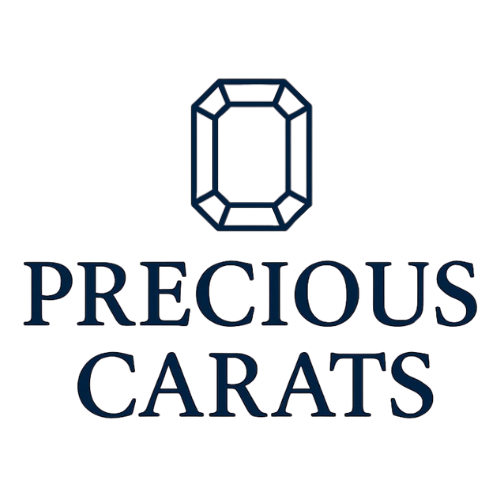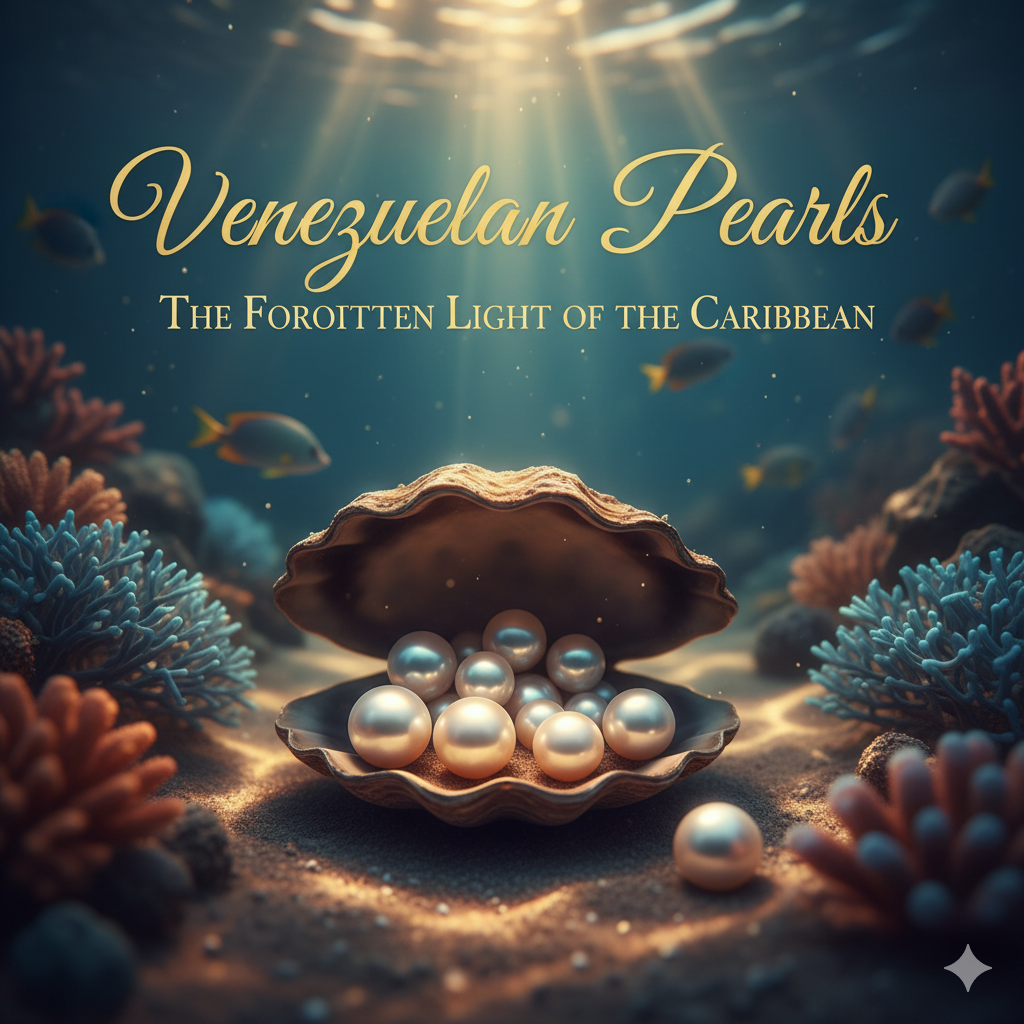Introduction
Before oil, before cacao, before gold, Venezuela’s wealth was pearls. Long before the first Spanish galleons sailed for silver in Peru or gold in Mexico, explorers arrived at the northeastern coast of Venezuela — the islands of Margarita, Cubagua, and Coche. These waters shimmered with oysters that quietly produced some of the world’s finest natural saltwater pearls, celebrated for their silvery glow and subtle Caribbean warmth.
For nearly a century, these islands were the heart of the global pearl trade, supplying royal crowns, European courts, and even Mughal India. And then, as suddenly as they rose, they disappeared from commerce — a civilization of oysters destroyed by human greed. Today, few remember that Venezuela once held the title of the world’s first great pearl empire. Its story of rise, fall, and rediscovery is one of beauty, caution, and a remarkable testament to nature’s patience and man’s appetite.
Geography & Origin — The Tri-Archipelago of Light
The Venezuelan Pearl Coast forms a luminous triangle along the northeastern Caribbean. Each island had its own role in the pearl story:
-
Isla de Margarita – the largest island, still inhabited and vibrant today.
-
Cubagua – smaller and arid, home to the earliest European settlement in South America, Nueva Cádiz, established in 1528.
-
Coche – a gentle, sandy island where divers rested after weeks underwater.
The pearls themselves were formed by two species of oysters: Pinctada imbricata radiata, a close relative of the Gulf oyster, and Pteria colymbus, the winged oyster, which produces natural pearls with silvery iridescence.
The Caribbean waters in this region are shallow, clear, and warm, flowing gently between coral beds and seagrass — perfect conditions for the slow, patient process of nacre deposition. Over centuries, tiny irritants became treasures, layer by layer, producing pearls of remarkable beauty.
The Spanish Conquest and the “Pearl Coast”
In 1498, Christopher Columbus sighted these islands on his third voyage. The glint of shells and the shimmer of pearls in native adornments immediately drew attention. Within a decade, the Spanish Crown organized pearling fleets off Cubagua and Margarita, intent on harvesting the wealth of the sea.
By 1510, thousands of pearls were being produced monthly. They were shipped to Seville, Lisbon, and Venice, then re-exported to the Islamic and Indian worlds. Basra, Goa, and Gujarat handled these pearls, though few knew their source by name.
Nueva Cádiz on Cubagua became the first European city in the Americas — built not on agriculture or gold, but on the fragile promise of oysters. Its tiled roofs, courtyards, and fountains were funded entirely by pearls that would adorn queens.
Yet the bounty had a dark side. Indigenous divers were enslaved, and the oyster beds were stripped bare. By 1530, the population had collapsed, and by 1541, a hurricane obliterated Nueva Cádiz, as if the sea reclaimed its treasures.
The Science of Venezuelan Pearls
Unlike Pinctada radiata of the Arabian Gulf, Venezuela’s Pinctada imbricata radiata produces smaller shells but pearls of extraordinary orient — silvery white with hints of rosé, cream, or gold. Occasionally, the winged oyster yields baroque or drop-shaped pearls in lavender, bronze, or blue-gray hues, prized for their irregular, painterly luster.
Key Features of Venezuelan Pearls:
-
Type: Natural saltwater (non-cultured)
-
Species: Pinctada imbricata radiata, Pteria colymbus
-
Size: 2–6 mm, occasionally up to 9 mm
-
Body Colour: Silver-white, ivory, or champagne-cream
-
Overtones: Rosé, gold, bluish, greenish
-
Luster: Soft yet vivid, with translucent depth
-
Shapes: Near-rounds, buttons, teardrops
Compared to Gulf pearls, Venezuelan pearls carry a subtle warmth — a sunlit blush beneath the surface — unlike the satin, subdued glow of Basra pearls.
Colour Spectrum & The Caribbean Glow
Venezuelan pearls display a rich chromatic range: icy white, pale rose, champagne, silver, and soft peach. Their orient behaves like oil on water — a gentle, moving film of iridescence. Collectors often describe it as “light under honey”: warm, intimate, and never harsh.
Unlike cultured pearls, each Venezuelan pearl feels hand-painted by nature, shaped by coral reefs, tides, and centuries of patience.
The Colonial Boom and Collapse
Between 1500 and 1550, Venezuelan pearls financed Spain’s expansion in the New World. They adorned the crowns of Charles V and Isabella I, decorated the robes of Spanish nobility, and were exchanged for Asian silks and spices. It is estimated that over 100 million pearls were harvested from Cubagua and surrounding islands in just 50 years.
However, greed outpaced natural regeneration. Oysters take 5–10 years to mature, but colonial divers stripped beds before reproduction cycles completed. Mortality among divers was high, and by the mid-1600s, Cubagua’s oyster banks were barren. Pearl fleets vanished, and the Pearl Coast fell silent.
The Long Sleep — And Rediscovery
For three centuries, Venezuelan pearling survived only in Spanish archives and Indian jewelry boxes. In the 1930s, marine biologists rediscovered wild oysters around Cubagua and Coche.
In the 1990s and 2000s, experimental sustainable pearl-farming programs emerged near Margarita, led by marine biologist Jorge F. Sánchez and the Universidad de Oriente. Using gentle seeding and ecological monitoring, these programs aimed to restore balance rather than mass-produce pearls.
Today, Venezuela’s natural pearls remain rare. Some jewelry houses source antique Venezuelan pearls, re-stringing them into heirloom pieces for collectors who appreciate history and beauty combined.
Venezuela vs. Bahrain vs. Japan — A Comparative Study
| Feature | Venezuela | Bahrain | Japan |
|---|---|---|---|
| Origin | Natural, Caribbean Sea | Natural, Arabian Gulf | Cultured, Pacific |
| Oyster | Pinctada imbricata radiata, Pteria colymbus | Pinctada radiata | Pinctada fucata martensii |
| Typical Colour | Cream-silver, champagne, rose | Ivory-cream, silvery-pink | White with rose or silver |
| Luster | Warm, transparent glow | Satin, deep orient | Sharp, mirror-like |
| Size | 2–9 mm | 2–7 mm | 6–9 mm |
| Shapes | Near-rounds, baroques | Round-to-off-round | Perfect rounds |
| Cultural Value | First global pearl source | Royal heritage, Middle East | Modern jewelry uniformity |
Venezuelan pearls uniquely bridge the heritage of Gulf naturals with the tropical clarity of the Caribbean, making them soulful and rare.
Cultural Footprint — From Seville to the Subcontinent
Pearls from Margarita and Cubagua traveled far and wide. They adorned Spanish and Portuguese nobility, reached the Vatican, and even Mughal India via Lisbon–Goa–Surat trade routes. In 17th-century Mughal inventories, pearls of “Margarita origin” appear alongside Gulf and Red Sea pearls.
Indian jewelers often blended Venezuelan and Basra pearls, creating necklaces where Caribbean warmth subtly complemented Gulf coolness — a fusion of oceans in a single strand.
Buying Guidance — How to Identify Venezuelan Pearls
Certification: Only a handful of labs (SSEF, GIA, DANAT, Gübelin) can confirm natural formation and Caribbean origin.
Visual Clues: Look for warmer tones, smooth nacre layering, and baroque or button shapes more frequent than perfect rounds.
Provenance: Check documentation for Cubagua, Coche, or Margarita references with “natural saltwater pearl (Caribbean).”
Pricing: Rarity drives value. Venezuelan pearls often command higher prices than Gulf pearls of similar quality, especially when orient, luster, and matching are exceptional.
Ecological Ethics & Sustainable Pearling
Modern Venezuelan pearl initiatives emphasize reef restoration over profit:
-
No-kill harvest: Pearls removed without harming oysters.
-
Reseeding: Juveniles returned to reefs to restore populations.
-
Support: Local cooperatives and marine biologists monitor ecological balance.
Every Venezuelan pearl today carries both natural beauty and ethical value — a gem with conscience.
Care & Maintenance
To preserve their delicate glow:
-
Wear often: Skin humidity nourishes nacre.
-
Avoid perfumes, sprays, and creams.
-
Wipe with a soft cloth after use.
-
Store flat in silk or suede pouches.
-
Re-string annually with knots between pearls.
-
Never immerse in ultrasonic cleaners or solvents.
These pearls are organic; their beauty is maintained through attention and care.
The Collector’s Eye — Why Venezuela Matters
Venezuelan pearls predate all other globally traded pearls. Surviving specimens are mostly in antique European or South American jewelry, or colonial church ornaments. Collectors can own one of the earliest ocean jewels ever exchanged across hemispheres — natural, ethical, and historically resonant.
Summary Checklist for Buyers
✅ Type: Natural Saltwater Pearl (not cultured)
✅ Region: Margarita / Cubagua / Coche, Venezuela
✅ Species: Pinctada imbricata radiata, Pteria colymbus
✅ Colour Range: Silver-white → Champagne → Rose-gold
✅ Luster: Warm, inner orient rather than surface shine
✅ Size: Typically 2–6 mm; larger rare and prized
✅ Shapes: Near-round, button, drop, baroque
✅ Certificate: SSEF / GIA / Gübelin / DANAT confirming “Natural Pearl (saltwater)”
✅ Provenance Notes: “Caribbean” or “Venezuelan origin” strengthens value
✅ Care: Wear often, keep away from chemicals, wipe after wear
Closing Note — The Return of the Caribbean Glow
The Basra pearl tells the story of faith and trade. The Venezuelan pearl tells the story of discovery and consequence.
When Columbus’s men dove into these crystalline waters five centuries ago, they did not realize they were touching an entire civilization — one that shimmered quietly beneath the sea, only to be destroyed and forgotten.
Today, as Venezuela rebuilds its reefs and reclaims its maritime identity, these pearls symbolize a second chance — for oceans, for artisans, and for beauty that does not cost the sea its life. The light of the Caribbean has not gone out. It only sleeps — waiting, once again, to rise from the oyster’s breath.

